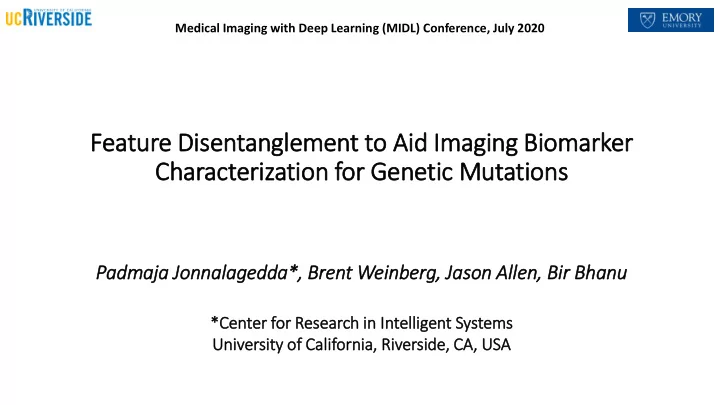

Medical Imaging with Deep Learning (MIDL) Conference, July 2020 Feature Dis isentanglement to Aid id Im Imaging Biomarker Characterization for Genetic Mutations Padmaja ja Jo Jonnala lagedda*, Brent Wei einberg, Ja Jason Alle llen, Bir ir Bhanu *Center for Research in *C in In Intelli lligent Systems Univ iversity of of Cali alifornia, Ri Riversid ide, CA, A, USA
Why? How? Extract visual features of 19/20 co-gain Mutated ⇒ What? Higher median survival
Challenges Training data > 80 samples per class • Lack of data Mutated: 31 patients • High class imbalance Control: 135 patients • High inter-class similarity • High intra-class diversity
Assessment pipeline Characterization • Are these features • Do visual indicators reproducible? exit? • Use GAN to try and • Classification using recreate these multiple state-of- • What are these indicators the-art models and features? validation methods • Isolate and quantify various macro- features Presence Reproducibility
Reproducibility of Biomarkers • If we use biomarkers to generate synthetic images, does it suggest mutation presence? • We propose a generative model which can tackle the following problems: • Limited data • High data diversity • Learns unapparent features FeaD-GAN: Feature Disentanglement GAN
Shape Loss Shape Shape Resampling Noise G Texture Texture Latent Space Texture Loss
Results: Quantitative RX: Representation of data (extent of features represented); ACC: Accuracy; SEN: Sensitivity; SPEC: Specificity and DIC: Dice Score. IL: Image Level; PL: Patient Level
Results: Qualitative
Conclusions • Visual indicators of mutations that correlate to median survival are present in MRI • Location, texture and shape are significant indicative features • The features are reproducible • FeaD-GAN: • Can faithfully generate good quality images from limited dataset • Can capture data diversity
Thank You! Acknowledgement This research is supported by the Bourns Endowment Fund at University of California Riverside
Recommend
More recommend